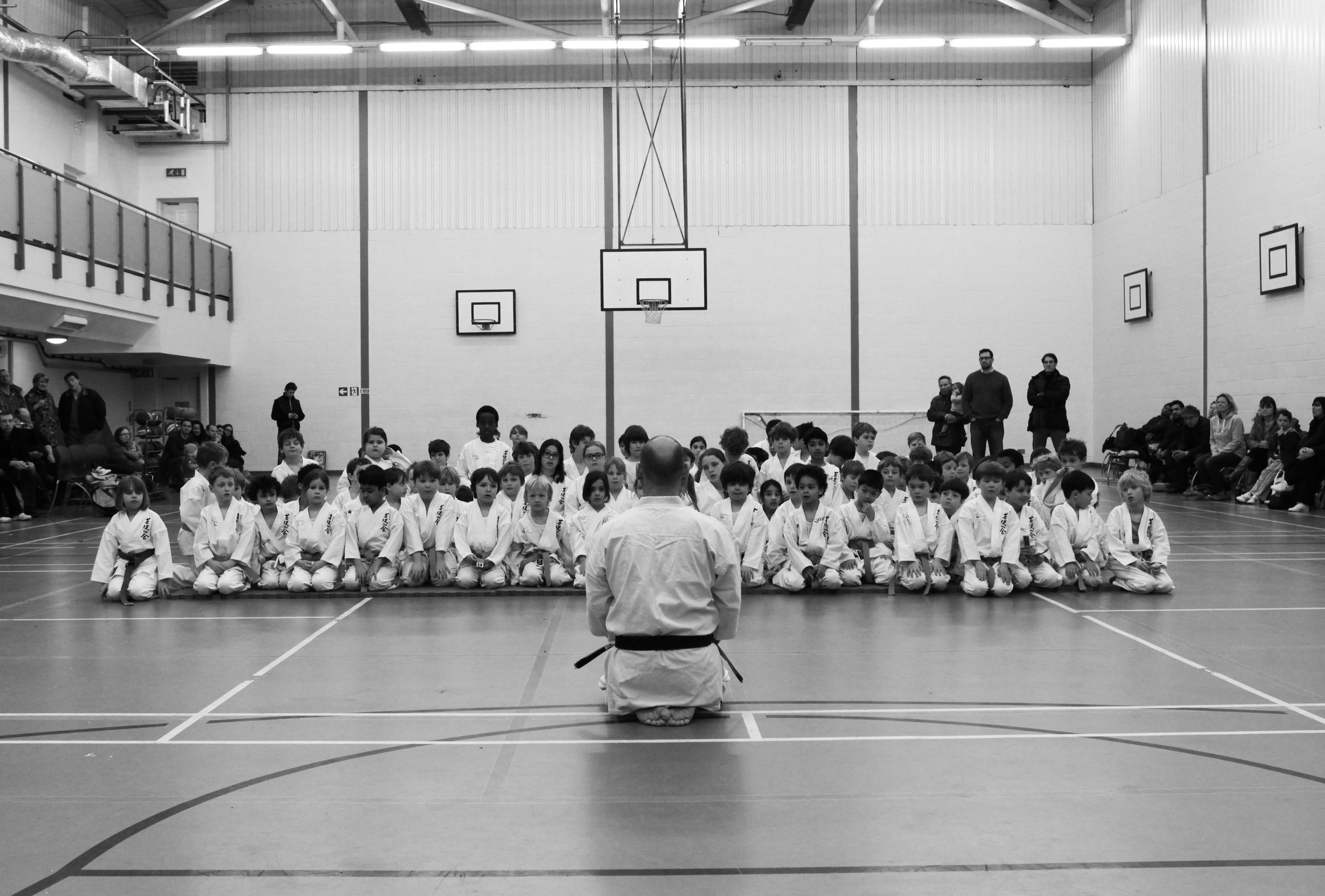
We specialise in teaching at schools.
Karate at Schools
Information for schools, parents and carers
Demonstrating wrist control
What is Karate?
Karate is an Okinawan and Japanese martial art based on a combination of striking and blocking techniques, joint locks and throws. Karate is taught through the practice of ‘Kihon’ (basic techniques); ‘Kata’ (choreographed individual performance sequences); and ‘Kumite’ (sparring and pre-arranged pair exercises). Progress is assessed by formal grading tests and marked by the award of coloured belts.
There is a formal and structured atmosphere in class. Participants bow at the beginning and end of lessons as a sign of courtesy, and students naturally pick up Japanese words and phrases through the class. However, English is our first and main language.
Parents and carers are encouraged to be fully informed about their children’s involvement in Karate. Staff are welcome to observe our lessons and we encourage sessions inviting parents to watch their children’s progress.
“Karate children show better speed times, explosive legs strength and coordination skills. They scored better on working memory, visual selective attention and executive functions. With concern to cognitive abilities, on the whole, children executing karate appear to have better cognitive functioning.”
“Motor and cognitive development: The role of Karate” in Muscles Ligaments Tendons Journal 2014
How safe is it?
Safety is our top priority.
Our Karate syllabus has been developed specifically for teaching in schools. Our instructors’ specialist skills and vast experience mean that the importance of good discipline is instilled and explained right from the beginning. Our instructors have a great understanding of the excitement and natural curiosity that children have, we want all our students to be safe first and foremost so that they can have fun.
Contact between participants is strictly controlled. For beginners, all contact is light and fully choreographed. ‘Free’ sparring is incrementally introduced later at appropriate times according to students’ increasing skills, but the aim is always to demonstrate the potential of techniques rather than to damage a training partner. No contact is allowed to the head.
The good behaviour of all participants is central to the safety of the class. The nature of karate, and the reputation of the club and school require that students treat the knowledge and skills that they learn responsibly, both in and out of the class. Any students who misbehave will not be allowed to participate. All instructors have an enhanced DBS, are insured and trained in first aid and have up to date safeguarding training. All relevant certification is available for inspection.
Coloured belts demonstrating at a schools tournament
Should my child take part?
One of the great strengths of Karate is that although it involves vigorous exercise, the only physical pre-requisite is that there is no serious medical condition that precludes participation. It is equally suited to girls and boys.
Self-defence is the underlying theme in Karate. However, it should be noted that this element is less relevant for young children. For this contingent, Karate is most valuable as an art in which all students can acquire real skills and artistry, regardless of their initial talent. In our experience, students enjoy Karate as a vigorous and interesting exercise that leads to improvements in coordination, fitness, flexibility, self-esteem, mutual trust, discipline and powers of concentration. Karate is also practised as a competitive sport, and UEKF members have achieved great success in competitions at regional, national and international level. At the very least, Karate provides a healthy alternative to sitting in front of a TV, computer or games console, and it’s fun to do!
Discipline and intensity, but great fun
How long?
The famous white to black belt system encourages and rewards persistence, a willingness to learn, and hard work . The most common question asked by beginners is, ‘How long does it take to get a black belt?’ In the UEKF, which is quite typical of traditional Karate schools, there are eleven belts, starting with the white one that comes with the uniform. Tests are required to pass through the system - the early ones are taken as early as three months apart, with subsequent intervals increasing so that there is a year between the last brown belt and the black belt test. Most students can expect to reach black belt within 5-6 years of training, but training can continue long beyond this milestone.
When?
Karate can be done as a before or after school, evening or weekend activity. We will work with you to find the best slot for Karate in your timetable. Some schools have found karate to be a fun and engaging PSHE or PE option as it is suited to children of all levels of ability.
Costs?
For club karate, we offer an all-inclusive membership for schools. The price per student per term includes: all tuition, a karate suit when students start, all gradings and belts and licence fee. The required annual licence covers membership of the UEKF and national governing body, EKF. In our experience, parents (and school finance offices) have much preferred this system as it avoids complicated “extras” billing at the end of term. This also gives our instructors the freedom to assess and grade students when they are ready
Depending on space, we can teach up to 25 children in a class group. For PSHE or PE classes, no uniform is required, PE kit is fine. For these classes, a fee per session for the instructor is charged.


